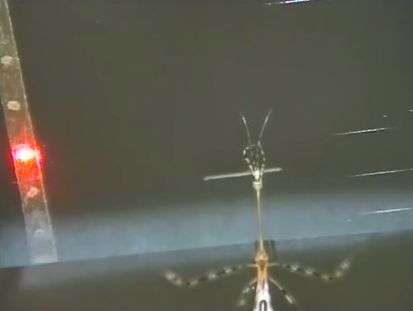October 26, 2016 report
Study shows how giraffe assassin bugs outwit spider prey

(Phys.org)—A biologist at Macquarie University in Australia has discovered the secret behind the giraffe assassin's ability to catch and kill spiders in their webs. In his paper published on the open access site Royal Society Open Science, Fernando Soley describes the study he conducted with the bugs and what he discovered.
Assassin bugs earned their name by stealthily sneaking up on prey and driving their beaks into the bodies of their victims, quickly killing them by sucking out their innards. The giraffe variety has a long neck and survives by sneaking up on spiders in their webs and killing and eating them. But scientists have wondered how the bugs manage the feat without being detected by the spiders. Spider webs are more than just nets used to catch flying insects; they are also transmitters of tiny movements that cause very small vibrations—this is how a spider knows if a bug has been trapped so that it can quickly hurry over and kill it before it escapes. But giraffe assassin bugs somehow make their way across a web without causing vibrations, allowing them to sneak up on their prey.
To solve the riddle, Soley captured several specimens and brought them back to his lab for testing. He also captured several spider specimens and coaxed them into spinning webs in the lab, as well. He aimed a laser at the webs as the assassin bugs stalked the spiders and filmed the results.The video revealed that the bugs used their foretarsi (tips of front legs) to grab hold of single strands of the web and then to gently pull them apart, tearing the web. The bugs then carefully released the torn strands, avoiding recoil, and moved on to another, making a beeline for the unsuspecting spider. The laser vibrometry sensor revealed that this technique allowed the assassin bugs to make their way to the spider without causing ripples in the web.
Soley also found that the assassin bugs prefer to stalk their prey when there is a slight breeze (in the lab he used a fan), which causes the web strands to shake, making it more difficult for the spider to detect subtle vibrations. He also noticed that the bugs varied the timing of slicing the web, which made it even more difficult for the spider to sense impending doom.
More information: Fernando G. Soley. Fine-scale analysis of an assassin bug's behaviour: predatory strategies to bypass the sensory systems of prey, Royal Society Open Science (2016). DOI: 10.1098/rsos.160573
Abstract
Some predators sidestep environments that render them conspicuous to the sensory systems of prey. However, these challenging environments are unavoidable for certain predators. Stenolemus giraffa is an assassin bug that feeds on web-building spiders; the web is the environment in which this predator finds its prey, but it also forms part of its preys' sophisticated sensory apparatus, blurring the distinction between environment and sensory systems. Stenolemus giraffa needs to break threads in the web that obstruct its path to the spiders, and such vibrations can alert the spiders. Using laser vibrometry, this study demonstrates how S. giraffa avoids alerting the spiders during its approach. When breaking threads, S. giraffa attenuates the vibrations produced by holding on to the loose ends of the broken thread and causing them to sag prior to release. In addition, S. giraffa releases the loose ends of a broken thread one at a time (after several seconds or minutes) and in this way spaces out the production of vibrations in time. Furthermore, S. giraffa was found to maximally reduce the amplitude of vibrations when breaking threads that are prone to produce louder vibrations. Finally, S. giraffa preferred to break threads in the presence of wind, suggesting that this araneophagic insect exploits environmental noise that temporarily impairs the spiders' ability to detect vibrations. The predatory behaviour of S. giraffa seems to be adaptated in intricate manner for bypassing the sophisticated sensory systems of web-building spiders. These findings illustrate how the physical characteristics of the environment, along with the sensory systems of prey can shape the predatory strategies of animals.
Journal information: Royal Society Open Science
© 2016 Phys.org


















